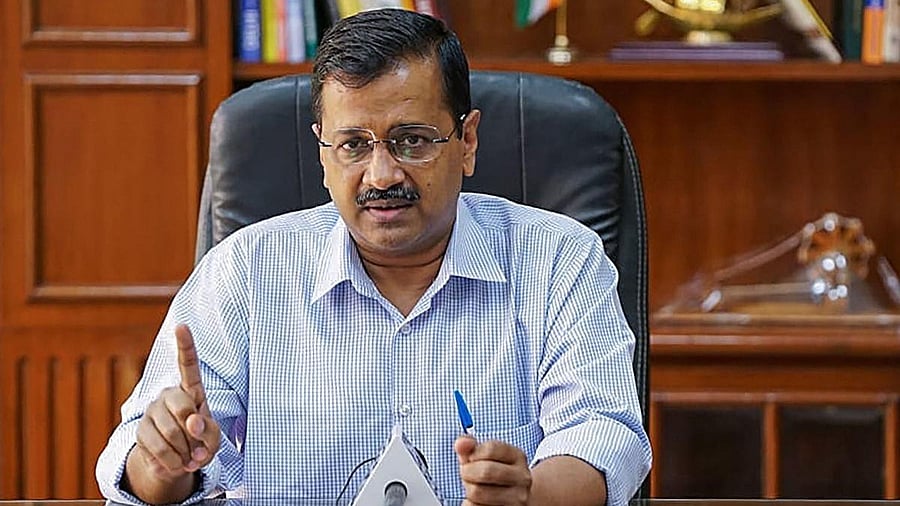
AAP supremo Arvind Kejriwal.
Credit: PTI File Photo
Jana Sangh, the Bharatiya Janata Party’s pre-Emergency avatar, tasted power for the first time in March 1967, when Lal Krishna Advani was elected chairman of the Delhi Metropolitan Council. By 1993, when the statehood of the national capital territory was restored, Advani had moved on to the national stage. Madan Lal Khurana, who had been handed over the baton, romped home with a comfortable majority to form the government.
Over the next five years, apart from the three BJP CMs—Khurana, Sahib Singh Verma, and Sushma Swaraj—a lot changed in Delhi. The first wave of globalization and the market economy created a new consumer class. Middle classes, accustomed to customized Doordarshan coverage, watched wars on cable TV streamed live by CNN. Engineers drew five-digit salaries, as hoards from the heartland states and elsewhere poured into the national capital region in search of employment and education.
BJP led by its first-generation post-partition migrant leadership like Khurana, V K Malhotra, and Kedar Nath Sahani somehow failed to discern this metamorphosis. It continued to rely on the Punjabi-Baniya vote base when the changing demography created an entirely new polity of the aspirational classes.
As the BJP missed the bus, Congress lapped up the opportunity by handing over the reins of the Delhi unit to Sheila Dikshit nee Kapoor, the former Congress MP from Kannauj in Uttar Pradesh who was married to party stalwart Uma Shankar Dikshit’s son Vijay.
Sheila Dikshit’s projection was a tactical move to cater to Punjabi and Poorvanchali sentiments. And it worked—not once but thrice.
Once the BJP lost power, it remained in opposition for 15 years.
When Congress finally lost in 2013, it was not to the BJP but a political start-up – Arvind Kejriwal’s Aam Aadmi Party.
While AAP weaned away Congress's traditional vote base in the lower middle class, and Delhi migrant workforce by offering a slew of welfare schemes, the BJP’s attempts at image makeover failed repeatedly.
At one point, Iron Lady, the former cop Kiran Bedi was roped in to take on Kejriwal. Manoj Tiwari, the Bhojpuri actor and Lok Sabha MP from Delhi, couldn’t make the cut. Home-bred veterans like Dr Harshvardhan too could not rattle the AAP juggernaut.
Interestingly, while the party missed every opportunity to resuscitate life into the state unit, the BJP did extremely well to win all 7 Lok Sabha seats in the last three elections since 2014. The trends would completely reverse when it came to assembly polls.
This time though, the BJP has entered the fray with a new strategy.
The BJP feels that the taint of the “liquor scam” has taken the veneer off Kejriwal’s ‘anti-corruption-crusader’ image. The alleged exorbitant expenditure on the renovation of the Delhi CM’s residence has worn out both the outsider and the outlier tags, bringing AAP to the conventional playing field. AAP MLAs, who are into their second and third terms face local anti-incumbency. And perhaps, most importantly, an aggressive Congress that has sought to reclaim its voter base in the national capital is making the contest tri-polar in pockets at the cost of AAP.
But would all this be enough to dislodge Kejriwal?
Acutely aware that it does not have a name and a face to match Kejriwal’s blitzkrieg in Delhi, BJP has not named a CM candidate for Delhi polls. Instead, the party is relying on Prime Minister Narendra Modi’s name and face to pull it off.
Politically speaking, in the last 10 years at the national level, AAP and its emergence have helped the BJP to indirectly contain its main opponent, the Indian National Congress. From Goa to Gujarat, a split in the non-BJP votes tends to benefit the saffron front and its allies.
Though unintentionally, Delhi is a small price BJP had to pay for this bargain. A weak AAP is something the BJP may prefer than a resurgent Congress.
It’s a tough choice, though, as Indian voters of late have been fairly regular in handing out decisive verdicts.
Delhi Assembly Election 2025 | The first of two state assembly polls this year sees a three-way contest between AAP, Congress, and BJP in the nation's capital. AAP decided to contest the polls alone, causing rumours of a rift in I.N.D.I.A. BJP, meanwhile, is hoping the liquor excise policy scam and pollution in Delhi will give the saffron party an edge over AAP. Kejriwal, on the other hand, has different plans with his demand for reservations for Delhi Jats. Congress will also be looking to make its presence felt and has not held back from attacking its own alliance partner. Check live updates and track the latest coverage, live news, in-depth opinions, and analyses only on Deccan Herald.
Subscribe and follow DH on Whatsapp, X, Facebook, YouTube, and Instagram to never miss out on anything.